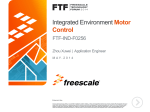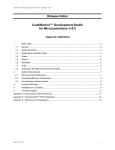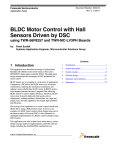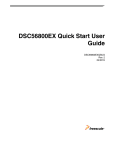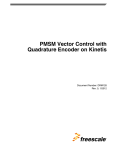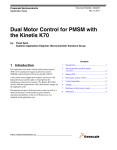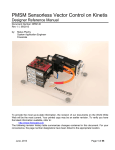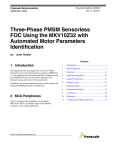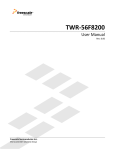Download PMSM FOC of Industrial Drives using the 56F84789
Transcript
Freescale Semiconductor Application Note Document Number:AN4656 Rev. 0, 01/2013 PMSM FOC of Industrial Drives using the 56F84789 by: Pavel Rech Contents 1 Introduction 1 Introduction............................................................1 This application note deals with the field-oriented control (FOC) of a permanent magnet synchronous motor (PMSM) with the DSC 56F84789. The incremental encoder is used for position and speed feedback in this application. This is the typical control algorithm used in industrial drives. The application is controlled by the powerful Freescale Digital Signal Controller (DSC) 56F84789 dedicated to advanced motor control applications. The DSC 56F84789 offers a rich and advanced peripheral set which includes programmable timers, an eFlexPWM module, analogue and communication modules, and so on. This application note describes the control algorithm, software design and hardware set-up using the Tower kit. 2 Application Features................................................2 3 DSC 56F844x/5x/7x Key Features.........................2 4 PMSM Control Principle........................................3 5 Application Operation.............................................5 6 System Concept.......................................................5 7 Tower DSC 56F84789 board..................................5 8 Peripherals for PMSM control................................7 9 Faults Protection......................................................9 10 State Machine..........................................................9 11 FreeMASTER and Motor Control Application Tuning Tool......................................10 12 References.............................................................13 © 2013 Freescale Semiconductor, Inc. Application Features Figure 1. The real application 2 Application Features • • • • Executing a field-oriented control algorithm for a PMSM Encoder on the shaft to sense the rotor position and speed Controlled by the DSC 56F84789 Both directions of rotation and two closed-loops implemented: • Speed closed-loop with a PI Controller • Current closed-loop with two PI Controllers • Speed range: 0 – 3000 rpm (field weakening is not implemented) • H/W used: • TWR-MC-LV3PH - Low-Voltage 3-Phase Motor Control Module • TWR-56F8400 - MC56F84789 Motor and Power Control MCU Module • User interface: • Using buttons on the Tower MCU board • Using a graphical interface in FreeMASTER • Autonomous mode – changing the required speed automatically • Tuning Wizard supported – easy setting of the control structure parameters 3 DSC 56F844x/5x/7x Key Features Each device in the 56F844x/5x/7x family, based on the 32-bit 56800EX core, combines, on a single chip, the processing power of a 32-bit DSP and the functionality of a microcontroller with a flexible set of peripherals. The 56F844x/5x/7x family can be characterized by the following: • cost-effectiveness • configuration flexibility • compact program code This device is suitable for many motor control or power conversion applications. The DSC 56F844x/5x/7x family has a modernized 56800EX core, which is based on a dual Harvard-style architecture consisting of three execution units operating in parallel, allowing as many as six operations per instruction cycle. The optimized instruction set allows straightforward generation of efficient, compact DSP and control code. The instruction set is also highly efficient for C compilers to enable rapid development of optimized control applications. The DSC from the 56F844x/5x/7x family supports up to 100 MHz PMSM FOC of Industrial Drives using the 56F84789 , Rev. 0, 01/2013 2 Freescale Semiconductor, Inc. PMSM Control Principle program execution from both internal flash memory and RAM. Both on-chip flash memory and RAM can also be mapped into both program and data memory spaces. Two data operands can be accessed from the on-chip data RAM per instruction cycle. Figure 2. MC56F84xx Block Diagram 4 PMSM Control Principle The FOC, or in other words the vector control, is one of the most widely used control methods not only for PMSM. The aim of field-oriented control is to separate the current loop by the system of coordinates on two components, and, by using them, control the motor torque and field excitation (magnetic flux) independently. If speed control is required, at least three controllers are necessary. The controllers are placed in various speed control loops depending on the time constants of the controlled quantities. Accordingly, there are two control loops implemented: • slow control loop – provides the speed regulation and compensates the mechanical time constant of the machine. The loop calculates the deviation between the required speed and the real rotor speed obtained from the rotor position time change. The PI controller processes the deviation and creates the required torque current component. This routine is called regularly, for example, by the PIT. The slow control loop is executed in 1ms. • fast control loop – regulates motor currents and compensates the electrical time constant of the stator circuit. This loop develops the motor torque and can also generate the field excitation in the case of optional field weakening. The current control loop ensures the following operations: • Using the Clark and Park Transformations, the two current components in rotating coordinates are transformed from the 3-phase sensed currents. • The direct-axis current component influences the field excitation of the machine, but owing to the permanent magnet, this component is kept at a zero value. PMSM FOC of Industrial Drives using the 56F84789 , Rev. 0, 01/2013 Freescale Semiconductor, Inc. 3 PMSM Control Principle • The quadrature-axis current component is proportional to the machine torque on conditions, such as constant the field excitation and keeping the electrical angle between the stator and the rotor flux at 90°. The Space Vector Modulation (SVM) generates three components of the phase voltages for the PWM module. This routine is called by ADC conversation complete interrupt. The fast control loop is typically executed in 62.5 µs (for a 16 kHz PWM frequency). • The current control loop is executed immediately when new values of currents are ready in the ADC result registers. The speed control loop has a lower priority and is executed as soon as the PIT overflow occurs. The ADC with PWM module synchronization through the crossbar ensures that two phase currents are sensed in the right time instance when the current flows in an applicable shunt resistor. Figure 3. PMSM Field-oriented Control Principle Figure 4. Application Code Structure PMSM FOC of Industrial Drives using the 56F84789 , Rev. 0, 01/2013 4 Freescale Semiconductor, Inc. Application Operation The incremental encoder is used as the position and speed sensor. It generates the A, B and Index signals processed by the Quad Timer in Quadrature count mode, which counts the actual rotor position. The encoder signals are processed in two ways. On the one hand, the pulses are counted during the constant period – convenient for higher speeds. On the other hand, the measuring time interval between encoder pulses is measured – convenient for low speeds. This speed processing method increases the precision of the speed measurement at the expense of the second quad timer module with capture functionality needed. 5 Application Operation The Application can be operated using two buttons, SW1 and SW2, or by using the FreeMASTER graphical control interface. The SW2 button first starts the control algorithm and then increases the speed. The SW1 button decreases the speed, turns off the application, clears a flag or turns the application to the autonomous mode. 6 System Concept The application is based on Freescale's modular development platform - the Tower system. Apart from the Tower system, this application includes the 3-Phase permanent magnet synchronous motor. There are two boards only in the Tower system: • TWR-MC-LV3PH – Low-Voltage 3-Phase Motor Control Module • TWR-56F8400 - MC56F84789 Motor and Power Control MCU Module These two boards are connected using the primary elevator module, the secondary elevator only keeps the Tower system together. The DSC board with the 56F84789 is placed in the top position of the Tower to enable control of the application using the buttons. The Figure 2 shows the peripheral set of the MC56F84xx family. For the motor control applications, 6 channels of the PWM module are necessary and 2 fast ADC modules with at least 5 channels. Synchronization of the PWM and the ADC module is an important feature. The MC56F84xx family has a CrossBar module which can easily provide synchronization. The Quadrature decoder is required to decode the Incremental encoder sensor signals. For some applications, can be the communication modules can be required. This application based on the Tower system requires the SPI module for MOSFET driver configuration. Similarly, the SCI communication interface is needed to control the application using the FreeMASTER. The other peripherals are optional. 7 Tower DSC 56F84789 board The Figure 5 denotes the Tower DSC board conception. There are three ways to supply power to the Tower DSC board • through the main power supply connector on the board, from 5 V to 9 V • through the mini-usb connector, with 5 V • through the elevator module with voltage generated by the low-voltage tower board This application uses the third possibility because the Low-Voltage 3-Phase Motor Control Module has to be supplied by 24 V, therefore this voltage is also used for the DSC tower boards. PMSM FOC of Industrial Drives using the 56F84789 , Rev. 0, 01/2013 Freescale Semiconductor, Inc. 5 Tower DSC 56F84789 board Figure 5. TWR MC56F84xx Block Diagram The following Figure 6 shows the real DSC board with components, buttons and their programmed functions. There are three buttons, the first one for an application reset and the next two buttons for controlling the application. Using these two buttons, the application can be set to run or stop, change the motor speed, clear the fault or switch to autonomous mode. Figure 6. TWR MC56F8400 PMSM FOC of Industrial Drives using the 56F84789 , Rev. 0, 01/2013 6 Freescale Semiconductor, Inc. Peripherals for PMSM control The motor is supplied by the Low-Voltage 3-Phase Motor Control Module offered by Freescale, which is determined for low-voltage motor control applications. The 3-Phase module does not only generate voltage pulses for supplying the stator, but this board can also process signals from the incremental encoder or Hall sensor and, of course, ensures the measurement of the phase currents, BEMF voltage, DC-bus current and voltage. Figure 7. Low-Voltage, 3-Phase Motor Control Tower System Module 8 Peripherals for PMSM control From the DSC peripheral perspective, the vector control of the PMSM requires a 6-channel PWM block for 3-phase sine wave generation, a time base for the speed control loop, and the ADCs synchronized with the PWM module for the current sensing. In the case of the encoder feedback, a timer with a quadrature decoding capability is required. The following table shows the list of peripherals used in the application. PMSM FOC of Industrial Drives using the 56F84789 , Rev. 0, 01/2013 Freescale Semiconductor, Inc. 7 Peripherals for PMSM control Figure 8. The 56F84789 peripherals overview for PMSM FOC The right peripheral interconnections are also necessary to execute the FOC. Figure 9 denotes the interaction among the control algorithm, peripheral and hardware. It is essential that PWM – ADC synchronization is realized through the crossbar switch. Figure 9. Peripheral Interconnection PMSM FOC of Industrial Drives using the 56F84789 , Rev. 0, 01/2013 8 Freescale Semiconductor, Inc. Faults Protection 9 Faults Protection The control algorithm includes protection against these faults: • S/W phase overcurrent based on ADC low/high limits automatic comparison. • S/W DC-bus overvoltage based on ADC high limit automatic comparison. • H/W DC-bus overcurrent based on driver functionality connected with the PWM module. • S/W over/under speed checked by control algorithm speed measurement. The DC-bus overcurrent is set to a higher value than the S/W phase overcurrent, which is set to a higher value then the current regulator limits. If a HW DC-bus overcurrent fault occurs, the driver will automatically turn off all MOSFETs even though the PWM module would generate the pulses. All faults are indicated by LED on the DSC tower board and by LED on 3-phase low-voltage module concurrently. The FreeMASTER directly indicates which faults occurred. 10 State Machine The application software is based on the application state machine built on 4 basic states and expanded using 4 run sub-states: • Initialization - initialize the variables and MOSFET driver. • Stop - control algorithm runs and the PWM module is disabled. • Run - control algorithm runs and the PWM module is enabled. • Calibration • Ready • Alignment • Rotation • Automatic mode • Fault - control algorithm runs, the PWM module is disabled and the fault is indicated. The application has to be in one of the basic states at anytime. The switching between states is ensured by short transition functions. The transition between the states can be done automatically (for example, from Init to Stop, or Run to Fault states), or called by the user through variables changing (for example, from Run to Stop state, or Rotation to Automatic mode substate). The state machine also supports a multi-motor solution. Information about, the actual state or sub-state is stored in variables and the transition between two states is possible only under satisfied logic conditions. The state machine structure allows for easy incorporation of customer specific code and provides a transparent structure of code. PMSM FOC of Industrial Drives using the 56F84789 , Rev. 0, 01/2013 Freescale Semiconductor, Inc. 9 FreeMASTER and Motor Control Application Tuning Tool Figure 10. Application State Machine 11 FreeMASTER and Motor Control Application Tuning Tool The FreeMASTER is a real-time debug monitor and data visualization tool. The graphical interface in FreeMASTER is a more comfortable way to control the application. In this way, the user has more possibilities and feedback over controlling the motor. Moreover, the actual speed values are measured and can be visualized in waveforms. PMSM FOC of Industrial Drives using the 56F84789 , Rev. 0, 01/2013 10 Freescale Semiconductor, Inc. FreeMASTER and Motor Control Application Tuning Tool Figure 11. FreeMASTER Graphic Control Interface The Recorder functionality of the FreeMASTER is excellent for watching what happens in the DSC during motor control processing. The recorder measurement is based on capturing the variables in periodic interrupts. This application uses measurement in the ADC interrupt service routine, meaning each measured sample can be visualized in the recorder. The following Figure 12 shows the example of a transient state of the application triggered by the recorder. This visualization tool supports up to 8 variables – placed according to user selection in up to 6 blocks, the arbitrary variables can be used for triggering. PMSM FOC of Industrial Drives using the 56F84789 , Rev. 0, 01/2013 Freescale Semiconductor, Inc. 11 FreeMASTER and Motor Control Application Tuning Tool Figure 12. The Response to a Change in Required Speed Captured by the Recorder The Tuning Wizard is an upper level motor control tool which enables easy parameter configuration of the control loops, motors or observers. Using this tool implemented in FreeMASTER, you can set up and tune the application constants without advanced motor control knowledge. After the drive has been tuned, you can save all constants to the application header file which will be used for project compilation. PMSM FOC of Industrial Drives using the 56F84789 , Rev. 0, 01/2013 12 Freescale Semiconductor, Inc. References Figure 13. Motor Control Application Tuning Tool Tuning wizard input parameters can be divided into three groups: Motor parameters, Application scales, Hardware scales. The motor parameters should be found in the motor datasheet. The application and hardware scales depend on the power stage used. The user should write the input application parameters and the parameters of the current and speed loops. The wizard will calculate the other parameters from input parameters after pressing the button Calculate. Then it is possible to write these values of current and speed loops directly into the application variables through FreeMASTER by clicking on button update FRM. The bookmark Output File displays the output header file which is used for writing the application constants directly to the DSC flash memory after compiling the project and downloading the code. 12 References • • • • • MC56F8458X Advance Information Data Sheet, available at freescale.com MC56F847xx Reference Manual, available at freescale.com TWR-MC-LV3PH User’s Manual, available at freescale.com Software will be available at freescale.com Tuning Wizard documentation will be available at freescale.com PMSM FOC of Industrial Drives using the 56F84789 , Rev. 0, 01/2013 Freescale Semiconductor, Inc. 13 How to Reach Us: Home Page: www.freescale.com Web Support: http://www.freescale.com/support USA/Europe or Locations Not Listed: Freescale Semiconductor Technical Information Center, EL516 2100 East Elliot Road Tempe, Arizona 85284 +1-800-521-6274 or +1-480-768-2130 www.freescale.com/support Europe, Middle East, and Africa: Freescale Halbleiter Deutschland GmbH Technical Information Center Schatzbogen 7 81829 Muenchen, Germany +44 1296 380 456 (English) +46 8 52200080 (English) +49 89 92103 559 (German) +33 1 69 35 48 48 (French) www.freescale.com/support Japan: Freescale Semiconductor Japan Ltd. Headquarters ARCO Tower 15F 1-8-1, Shimo-Meguro, Meguro-ku, Tokyo 153-0064 Japan 0120 191014 or +81 3 5437 9125 [email protected] Asia/Pacific: Freescale Semiconductor China Ltd. Exchange Building 23F No. 118 Jianguo Road Chaoyang District Beijing 100022 China +86 10 5879 8000 [email protected] Document Number: AN4656 Rev. 0, 01/2013 Information in this document is provided solely to enable system and software implementers to use Freescale Semiconductors products. There are no express or implied copyright licenses granted hereunder to design or fabricate any integrated circuits or integrated circuits based on the information in this document. Freescale Semiconductor reserves the right to make changes without further notice to any products herein. Freescale Semiconductor makes no warranty, representation, or guarantee regarding the suitability of its products for any particular purpose, nor does Freescale Semiconductor assume any liability arising out of the application or use of any product or circuit, and specifically disclaims any liability, including without limitation consequential or incidental damages. "Typical" parameters that may be provided in Freescale Semiconductor data sheets and/or specifications can and do vary in different applications and actual performance may vary over time. All operating parameters, including "Typicals", must be validated for each customer application by customer's technical experts. Freescale Semiconductor does not convey any license under its patent rights nor the rights of others. Freescale Semiconductor products are not designed, intended, or authorized for use as components in systems intended for surgical implant into the body, or other applications intended to support or sustain life, or for any other application in which failure of the Freescale Semiconductor product could create a situation where personal injury or death may occur. Should Buyer purchase or use Freescale Semiconductor products for any such unintended or unauthorized application, Buyer shall indemnify Freescale Semiconductor and its officers, employees, subsidiaries, affiliates, and distributors harmless against all claims, costs, damages, and expenses, and reasonable attorney fees arising out of, directly or indirectly, any claim of personal injury or death associated with such unintended or unauthorized use, even if such claims alleges that Freescale Semiconductor was negligent regarding the design or manufacture of the part. RoHS-compliant and/or Pb-free versions of Freescale products have the functionality and electrical characteristics as their non-RoHS-complaint and/or non-Pb-free counterparts. For further information, see http://www.freescale.com or contact your Freescale sales representative. For information on Freescale's Environmental Products program, go to http://www.freescale.com/epp. Freescale™ and the Freescale logo are trademarks of Freescale Semiconductor, Inc. All other product or service names are the property of their respective owners. © 2013 Freescale Semiconductor, Inc.














